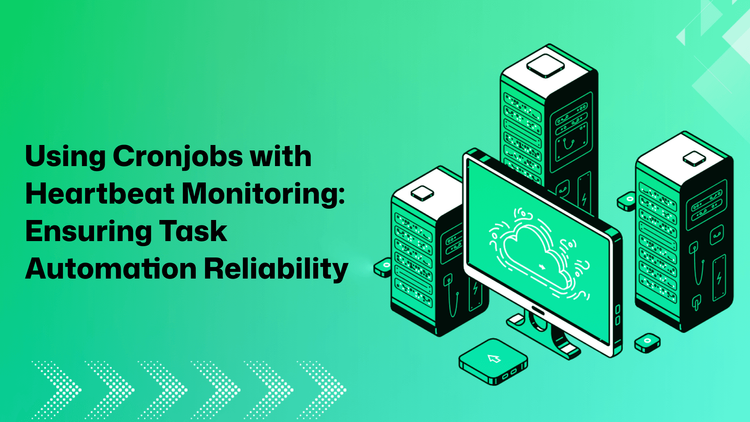Using Cronjobs with Heartbeat Monitoring: Ensuring Task Automation Reliability

1. Introduction
Cronjobs are a cornerstone of Linux systems, automating tasks like backups, service restarts, and scheduled API calls.
In today's dynamic environments, the reliability of these automated tasks is paramount for the success of any business-critical system. Unreliable cronjobs can lead to data loss, service outages, and significant operational disruptions.
This article explores the challenges of traditional cronjob monitoring and introduces heartbeat monitoring as a robust solution to ensure the consistent and reliable execution of critical tasks.
2. Challenges with Traditional Cronjob Monitoring
2.1 Lack of Real-Time Failure Alerts
- Problem: Traditional cronjob monitoring relies heavily on passive logging mechanisms (
/var/log/syslog,journalctl) with no proactive alerting capabilities. System administrators must manually parse through extensive log files to identify failed executions, creating a significant delay between failure occurrence and detection. Consider this common scenario:
# Critical backup job running daily
0 2 * * * /usr/local/scripts/backup-production.sh > /dev/null 2>&1The script executes silently, and failures remain undetected until the next manual log review or, worse, until the backup is needed.
- Impact:
- Critical Data Vulnerability: Database backups, system snapshots, and compliance-related tasks may fail silently for days or weeks, creating substantial data protection gaps
- Resource Drain: IT teams spend hours per week manually reviewing cron logs across distributed systems
- Compliance Risks: Automated regulatory compliance tasks may fail without notification, potentially violating industry standards and corporate policies
2.1 Difficulty Detecting Silent Failures
- Problem: Modern cronjobs often involve complex operations that can fail in subtle ways while still reporting successful execution. Consider this deceptively simple scenario:
# Data synchronization job
*/30 * * * * /usr/local/bin/sync-data.py --quietThe script might report success despite:
- Partial data transfers due to network timeouts
- Incomplete processing due to memory constraints
- Failed API calls with fallback to cached data
- Database connection pools exhaustion
Traditional monitoring tools focus solely on execution status, missing these nuanced failure modes entirely.
- Impact:
- Operational Blind Spots: Teams operate under false assumptions about automated task completion
- Cascading Failures: Interconnected systems depending on cronjob outputs experience downstream issues
- Business Process Disruption: Critical operations like order processing, billing cycles, or inventory updates face undetected disruptions
2.3 Limited Visibility and Troubleshooting Complexity
- Problem: Modern infrastructure spans multiple environments and scheduling systems:
Enterprise Scheduling Ecosystem
├── On-Premise Cron Jobs
├── Cloud Schedulers
│ ├── AWS EventBridge
│ ├── GCP Cloud Scheduler
│ └── Azure WebJobs
└── Container Orchestration
└── Kubernetes CronJobsEach system maintains its own logging format, execution environment, and monitoring paradigm. This fragmentation creates significant challenges in maintaining comprehensive visibility across the automation landscape.
- Impact:
- Increased Operational Overhead: Managing multiple monitoring tools and dashboards increases complexity and training requirements
- Scalability Challenges: As infrastructure grows, manual monitoring becomes exponentially more complex
- Missed Dependencies: Interconnected tasks across different scheduling systems create hidden failure points that evade detection
3. Heartbeat Monitoring: How It Ensures Cronjobs’s Reliability
3.1 Understanding Heartbeat Monitoring
- Definition and Core Concepts Heartbeat monitoring operates on a fundamental principle: regular signals ("heartbeats") transmitted at predetermined intervals confirm the operational status of automated tasks. Think of it as a continuous health check system for your automation infrastructure.
# Example: Basic heartbeat implementation
./db-backup.sh && curl -X POST "<https://uptime-api.bubobot.com/api/heartbeat/8eT13rpymUbAuu5OTaga>"3.2 Critical Role in Cronjob’s Reliability
- Real-Time Execution Validation
- Active Verification: Transforms passive logging into proactive monitoring through instant heartbeat signals
- Instant Detection: Slashes failure detection time from hours to minutes
- Execution Timeline: Ensures critical tasks operate within their designated time windows, preventing silent timeouts
- Task Completion Validation
- Deep Validation: Moves beyond simple execution checks to verify successful task completion
- Resource Oversight: Monitors system resources throughout task execution cycles
- Output Integrity: Validates task outcomes against predefined success criteria, catching subtle failures
- Unified Monitoring Interface
- Centralized Control: Provides a single source of truth for automation health across all environments
- Cross-Platform Integration: Seamlessly monitors tasks across cloud services, containers, and traditional servers
- Dependency Mapping: Visualizes task relationships to quickly identify failure impact chains
4. Implementing Robust Heartbeat Monitoring with Bubobot
4.1 Bubobot's Comprehensive Monitoring Solution
As a reliable pingdom alternative, Bubobot addresses the core challenges of traditional cronjob monitoring, ensuring your critical processes run with precision and reliability. Let's dive into how Bubobot transforms benefits into practical reliability.
- Streamlined Setup Process
- Simple Integration: Quick implementation with existing cronjobs
- Flexible Configuration: Customizable monitoring intervals and thresholds
- Intelligent Alert Management
- Multi-Channel Notifications: Instant alerts via preferred channels
- Smart Escalation: Automated alert routing based on severity
- Real-Time Visibility
- Unified Dashboard: Comprehensive view of all automated tasks
- Audit Trail: Complete history of task execution patterns
4.2 How Bubobot’s Heartbeat Monitoring Works
- Step 1: Your cronjob sends a quick "I'm alive!" signal to Bubobot after it finishes.
- Step 2: Bubobot watches for these signals at the expected times.

- Step 3: If a signal is missing, Bubobot alerts you ASAP.
- Step 4: Track everything in real-time on the Bubobot dashboard. Every time a job fails to run, Bubobot records the event.

Bubobot logs every missed job with clear status, timestamps, and duration for easy troubleshooting.
5. Conclusion
Ensuring the reliability of your cronjobs is crucial for maintaining business continuity and minimizing operational disruptions.
Bubobot's server uptime monitoring provides the proactive visibility and real-time alerting you need to identify and address cronjob failures promptly. By embracing heartbeat monitoring, you can significantly improve the reliability of your automated tasks and reduce the risk of costly downtime.
Explore Bubobot's Heartbeat Monitoring today and ensure your cronjobs never miss a beat!
#Cronjobs, #TaskAutomation, #Reliability